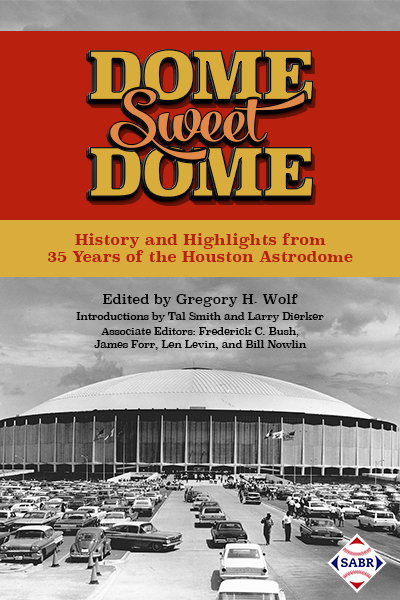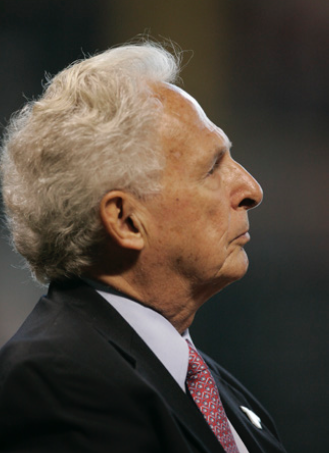Tal Smith: Reflections on the Opening of the Astrodome
This article was written by Tal Smith
This article was published in Dome Sweet Dome: History and Highlights from 35 Years of the Houston Astrodome
 I have been fortunate to work in professional baseball for almost 60 years. It has been an interesting career with many treasured and exciting experiences, and I am frequently asked what is my fondest or greatest memory.
I have been fortunate to work in professional baseball for almost 60 years. It has been an interesting career with many treasured and exciting experiences, and I am frequently asked what is my fondest or greatest memory.
Most of my career (35 years over three different intervals) was spent with the Houston Astros. During the years I served as general manager or president of baseball operations, there were many thrilling games and notable accomplishments. The first divisional championship in 1980 followed by the exciting playoff series with the Phillies, and the winning of the National League pennant in 2005, which led to the first World Series in Texas, certainly stand out and will live forever among my cherished memories. Many particular games and individual performances by Astro players also come to mind when recalling past events that left an indelible mark.
But wins on the field are often short-lived. There is always another game to play or another season that follows. The joy of winning is often offset at some future point by disappointment. In my memory bank, however, there is one event of a more lasting nature: the opening of the Astrodome in April 1965.
Actually, my association with the Astrodome began when it was not much more than a hole in the ground in 1963. I had achieved my boyhood dream of a job with a major-league baseball team when I joined the Cincinnati Reds in 1958. In the fall of 1960 Houston was awarded an expansion franchise in the National League, and Gabe Paul, who had been my boss as general manager of the Reds, asked me to accompany him to Houston when he accepted a similar position as GM of the fledgling franchise. By 1963, Gabe had left and become president of the Cleveland Indians. I was on the verge of joining him in Cleveland when Judge Roy Hofheinz summoned me to his office.
Judge Hofheinz and R.E. “Bob” Smith were the principal owners of the Houston Sports Association (“HSA”), the corporate entity that operated the ballclub (known as the Colt .45s at that time and renamed Astros just before the opening of the Astrodome). It was Hofheinz who conceived of the then unheard-of idea of building a multipurpose stadium that would be covered and air-conditioned so as to comfort and shelter baseball fans from Houston’s hot and humid atmosphere and provide a venue that would host trade shows, conventions, and other sport and entertainment attractions throughout the year regardless of the elements. The Judge was clearly the visionary who came up with the idea and the master salesman, promoter, and politician who pushed the project, overcame the skeptics and other obstacles, and made it a reality.
When I met with the Judge that day in early April 1963, I had no idea what he had in mind. Like all others with the team, I had become fascinated and somewhat mesmerized listening to his oratory about what would become the world’s first air-conditioned, covered stadium, but up until that time the emphasis had been centered on raising public support and public funding. The site itself was a big hole that had been excavated and then sat dormant until a second bond issue was passed.
 I was aware that construction contracts had been awarded and that there was now activity at the job site, but I was completely surprised when the Judge asked me to abandon my plans to leave and to instead stay on and serve as the liaison and project manager for the HSA during the construction period. My five years of baseball experience in Cincinnati and Houston had all been related to player development and player evaluation. I professed this to the Judge and reminded him that I was not an architect or engineer. He obviously knew this and proceeded to sell me on the idea that I could do it and that I should do it.
I was aware that construction contracts had been awarded and that there was now activity at the job site, but I was completely surprised when the Judge asked me to abandon my plans to leave and to instead stay on and serve as the liaison and project manager for the HSA during the construction period. My five years of baseball experience in Cincinnati and Houston had all been related to player development and player evaluation. I professed this to the Judge and reminded him that I was not an architect or engineer. He obviously knew this and proceeded to sell me on the idea that I could do it and that I should do it.
After some reflection it seemed to me to be an exciting challenge and a once-in-a-lifetime opportunity to become involved in such a unique project. How right I was and how thankful I am that I acceded to the Judge’s request.
I did sense, though, that I was faced with a “sink or swim” situation so I quickly became immersed in the raft of architectural, structural , mechanical, and electrical drawings, the hundreds of pages of job specifications and other documents related to the building of what was to become known as the Astrodome. There is no greater way to learn than when faced with necessity. Thus began a fascinating journey for the next 2½ years.
The construction of the Astrodome was a superb team effort. An extraordinary group of architects and engineers, most of whom were Houston firms, designed the building and its innovative features. There was obviously no similar air-conditioned, covered stadium or buildings of this magnitude to serve as a model. Consequently, there were no script or existing blueprints to guide the designers in the initial design or in coping with issues or problems that might arise in the actual construction stage.
The general contractor and the subcontractors and their suppliers all seemed to recognize what was at hand – the opportunity to participate in a historic endeavor and to add their name to what would become known as “The Eighth Wonder of the World.” Job-site issues were usually quickly resolved, and demanding schedules were met.
Many sports teams played in the Astrodome in the ensuing years but none had a more profound effect than the first team that was on the site – the professionals who built this majestic stadium that went on to serve as a model for stadiums worldwide. Air-conditioned, covered stadiums with upholstered seats and unobstructed sight lines, entertaining video displays, restaurants and clubs, luxurious suites, and other amenities are the norm today, but who knows when they might have come about if not for Judge Hofheinz’s novel concept and those who carried out his vision.
I obviously have a lot of memories of the process and those who were involved. Recollections of the many great events that took place in The Dome are too numerous to catalog or to rate in any order of significance without doing an injustice to others equally deserving.
For me, however, the one most memorable event in my professional life occurred in the early morning hours on April 9, 1965, a few short hours before the first public event – the exhibition game with the Yankees –when I stood in the center of the field in a silent stadium with the house lights on and marveled at what had been accomplished.
TAL SMITH has been a SABR member since 1982. He spent 54 years working in Major League Baseball front offices. In three separate stints with the Houston Colt .45s/Astros that spanned a total of 35 years, he held positions as the franchise’s Farm System Director, Vice-President of Player Personnel, General Manager, and President of Baseball Operations. As an assistant to Judge Roy Hofheinz, the president of the Houston Sports Association, Tal helped to oversee the construction of the Astrodome and later was responsible for finding the stadium’s synthetic playing surface that came to be known as AstroTurf. As General Manager, he assembled the Astros’ first playoff team, for which he was recognized as The Sporting News’ Major League Executive of the Year in 1980. Tal and his wife, Jonnie, reside in Houston; they have two children, Valerie and Randy. Randy followed in his father’s footsteps and, at age 29, became the youngest general manager in MLB history when he took the reins for the San Diego Padres in 1993.


